Xinyuan Liu
Alignment Tipping Process: How Self-Evolution Pushes LLM Agents Off the Rails
Oct 06, 2025



Abstract:As Large Language Model (LLM) agents increasingly gain self-evolutionary capabilities to adapt and refine their strategies through real-world interaction, their long-term reliability becomes a critical concern. We identify the Alignment Tipping Process (ATP), a critical post-deployment risk unique to self-evolving LLM agents. Unlike training-time failures, ATP arises when continual interaction drives agents to abandon alignment constraints established during training in favor of reinforced, self-interested strategies. We formalize and analyze ATP through two complementary paradigms: Self-Interested Exploration, where repeated high-reward deviations induce individual behavioral drift, and Imitative Strategy Diffusion, where deviant behaviors spread across multi-agent systems. Building on these paradigms, we construct controllable testbeds and benchmark Qwen3-8B and Llama-3.1-8B-Instruct. Our experiments show that alignment benefits erode rapidly under self-evolution, with initially aligned models converging toward unaligned states. In multi-agent settings, successful violations diffuse quickly, leading to collective misalignment. Moreover, current reinforcement learning-based alignment methods provide only fragile defenses against alignment tipping. Together, these findings demonstrate that alignment of LLM agents is not a static property but a fragile and dynamic one, vulnerable to feedback-driven decay during deployment. Our data and code are available at https://github.com/aiming-lab/ATP.
Semantic-decoupled Spatial Partition Guided Point-supervised Oriented Object Detection
Jun 12, 2025Abstract:Recent remote sensing tech advancements drive imagery growth, making oriented object detection rapid development, yet hindered by labor-intensive annotation for high-density scenes. Oriented object detection with point supervision offers a cost-effective solution for densely packed scenes in remote sensing, yet existing methods suffer from inadequate sample assignment and instance confusion due to rigid rule-based designs. To address this, we propose SSP (Semantic-decoupled Spatial Partition), a unified framework that synergizes rule-driven prior injection and data-driven label purification. Specifically, SSP introduces two core innovations: 1) Pixel-level Spatial Partition-based Sample Assignment, which compactly estimates the upper and lower bounds of object scales and mines high-quality positive samples and hard negative samples through spatial partitioning of pixel maps. 2) Semantic Spatial Partition-based Box Extraction, which derives instances from spatial partitions modulated by semantic maps and reliably converts them into bounding boxes to form pseudo-labels for supervising the learning of downstream detectors. Experiments on DOTA-v1.0 and others demonstrate SSP\' s superiority: it achieves 45.78% mAP under point supervision, outperforming SOTA method PointOBB-v2 by 4.10%. Furthermore, when integrated with ORCNN and ReDet architectures, the SSP framework achieves mAP values of 47.86% and 48.50%, respectively. The code is available at https://github.com/antxinyuan/ssp.
Neural-Augmented Kelvinlet: Real-Time Soft Tissue Deformation with Multiple Graspers
Jun 06, 2025Abstract:Fast and accurate simulation of soft tissue deformation is a critical factor for surgical robotics and medical training. In this paper, we introduce a novel physics-informed neural simulator that approximates soft tissue deformations in a realistic and real-time manner. Our framework integrates Kelvinlet-based priors into neural simulators, making it the first approach to leverage Kelvinlets for residual learning and regularization in data-driven soft tissue modeling. By incorporating large-scale Finite Element Method (FEM) simulations of both linear and nonlinear soft tissue responses, our method improves neural network predictions across diverse architectures, enhancing accuracy and physical consistency while maintaining low latency for real-time performance. We demonstrate the effectiveness of our approach by performing accurate surgical maneuvers that simulate the use of standard laparoscopic tissue grasping tools with high fidelity. These results establish Kelvinlet-augmented learning as a powerful and efficient strategy for real-time, physics-aware soft tissue simulation in surgical applications.
TopoPoint: Enhance Topology Reasoning via Endpoint Detection in Autonomous Driving
May 23, 2025Abstract:Topology reasoning, which unifies perception and structured reasoning, plays a vital role in understanding intersections for autonomous driving. However, its performance heavily relies on the accuracy of lane detection, particularly at connected lane endpoints. Existing methods often suffer from lane endpoints deviation, leading to incorrect topology construction. To address this issue, we propose TopoPoint, a novel framework that explicitly detects lane endpoints and jointly reasons over endpoints and lanes for robust topology reasoning. During training, we independently initialize point and lane query, and proposed Point-Lane Merge Self-Attention to enhance global context sharing through incorporating geometric distances between points and lanes as an attention mask . We further design Point-Lane Graph Convolutional Network to enable mutual feature aggregation between point and lane query. During inference, we introduce Point-Lane Geometry Matching algorithm that computes distances between detected points and lanes to refine lane endpoints, effectively mitigating endpoint deviation. Extensive experiments on the OpenLane-V2 benchmark demonstrate that TopoPoint achieves state-of-the-art performance in topology reasoning (48.8 on OLS). Additionally, we propose DET$_p$ to evaluate endpoint detection, under which our method significantly outperforms existing approaches (52.6 v.s. 45.2 on DET$_p$). The code is released at https://github.com/Franpin/TopoPoint.
TopoLogic: An Interpretable Pipeline for Lane Topology Reasoning on Driving Scenes
May 23, 2024



Abstract:As an emerging task that integrates perception and reasoning, topology reasoning in autonomous driving scenes has recently garnered widespread attention. However, existing work often emphasizes "perception over reasoning": they typically boost reasoning performance by enhancing the perception of lanes and directly adopt MLP to learn lane topology from lane query. This paradigm overlooks the geometric features intrinsic to the lanes themselves and are prone to being influenced by inherent endpoint shifts in lane detection. To tackle this issue, we propose an interpretable method for lane topology reasoning based on lane geometric distance and lane query similarity, named TopoLogic. This method mitigates the impact of endpoint shifts in geometric space, and introduces explicit similarity calculation in semantic space as a complement. By integrating results from both spaces, our methods provides more comprehensive information for lane topology. Ultimately, our approach significantly outperforms the existing state-of-the-art methods on the mainstream benchmark OpenLane-V2 (23.9 v.s. 10.9 in TOP$_{ll}$ and 44.1 v.s. 39.8 in OLS on subset_A. Additionally, our proposed geometric distance topology reasoning method can be incorporated into well-trained models without re-training, significantly boost the performance of lane topology reasoning. The code is released at https://github.com/Franpin/TopoLogic.
Computational Spectral Imaging with Unified Encoding Model: A Comparative Study and Beyond
Dec 20, 2023Abstract:Computational spectral imaging is drawing increasing attention owing to the snapshot advantage, and amplitude, phase, and wavelength encoding systems are three types of representative implementations. Fairly comparing and understanding the performance of these systems is essential, but challenging due to the heterogeneity in encoding design. To overcome this limitation, we propose the unified encoding model (UEM) that covers all physical systems using the three encoding types. Specifically, the UEM comprises physical amplitude, physical phase, and physical wavelength encoding models that can be combined with a digital decoding model in a joint encoder-decoder optimization framework to compare the three systems under a unified experimental setup fairly. Furthermore, we extend the UEMs to ideal versions, namely, ideal amplitude, ideal phase, and ideal wavelength encoding models, which are free from physical constraints, to explore the full potential of the three types of computational spectral imaging systems. Finally, we conduct a holistic comparison of the three types of computational spectral imaging systems and provide valuable insights for designing and exploiting these systems in the future.
Rethinking Boundary Discontinuity Problem for Oriented Object Detection
May 17, 2023



Abstract:Oriented object detection has been developed rapidly in the past few years, where rotation equivariant is crucial for detectors to predict rotated bounding boxes. It is expected that the prediction can maintain the corresponding rotation when objects rotate, but severe mutational in angular prediction is sometimes observed when objects rotate near the boundary angle, which is well-known boundary discontinuity problem. The problem has been long believed to be caused by the sharp loss increase at the angular boundary during training, and widely used IoU-like loss generally deal with this problem by loss-smoothing. However, we experimentally find that even state-of-the-art IoU-like methods do not actually solve the problem. On further analysis, we find the essential cause of the problem lies at discontinuous angular ground-truth(box), not just discontinuous loss. There always exists an irreparable gap between continuous model ouput and discontinuous angular ground-truth, so angular prediction near the breakpoints becomes highly unstable, which cannot be eliminated just by loss-smoothing in IoU-like methods. To thoroughly solve this problem, we propose a simple and effective Angle Correct Module (ACM) based on polar coordinate decomposition. ACM can be easily plugged into the workflow of oriented object detectors to repair angular prediction. It converts the smooth value of the model output into sawtooth angular value, and then IoU-like loss can fully release their potential. Extensive experiments on multiple datasets show that whether Gaussian-based or SkewIoU methods are improved to the same performance of AP50 and AP75 with the enhancement of ACM.
Contrastive Label Enhancement
May 16, 2023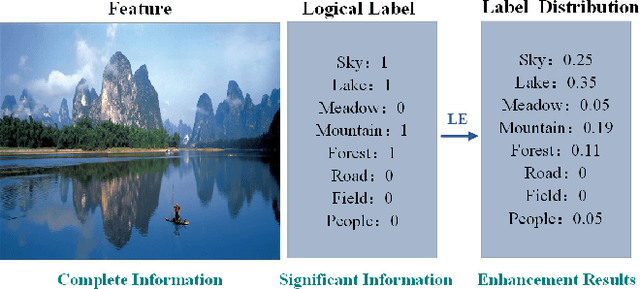
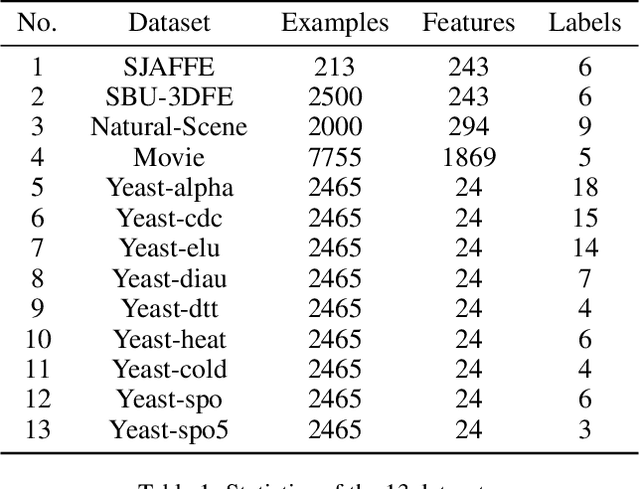
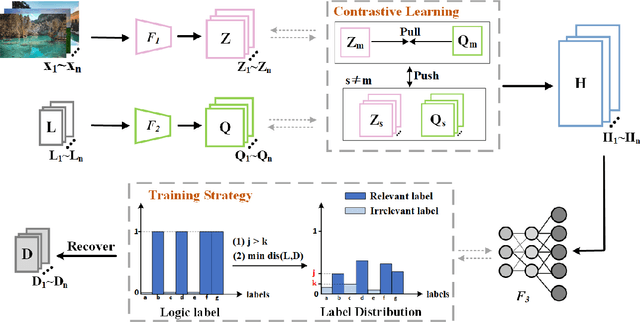
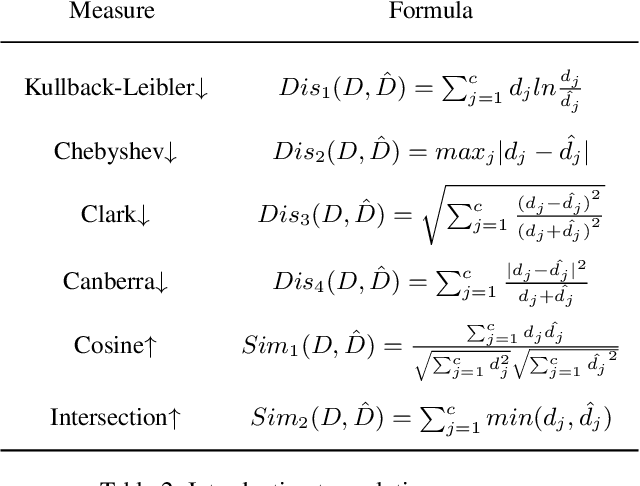
Abstract:Label distribution learning (LDL) is a new machine learning paradigm for solving label ambiguity. Since it is difficult to directly obtain label distributions, many studies are focusing on how to recover label distributions from logical labels, dubbed label enhancement (LE). Existing LE methods estimate label distributions by simply building a mapping relationship between features and label distributions under the supervision of logical labels. They typically overlook the fact that both features and logical labels are descriptions of the instance from different views. Therefore, we propose a novel method called Contrastive Label Enhancement (ConLE) which integrates features and logical labels into the unified projection space to generate high-level features by contrastive learning strategy. In this approach, features and logical labels belonging to the same sample are pulled closer, while those of different samples are projected farther away from each other in the projection space. Subsequently, we leverage the obtained high-level features to gain label distributions through a welldesigned training strategy that considers the consistency of label attributes. Extensive experiments on LDL benchmark datasets demonstrate the effectiveness and superiority of our method.
Bidirectional Loss Function for Label Enhancement and Distribution Learning
Jul 07, 2020
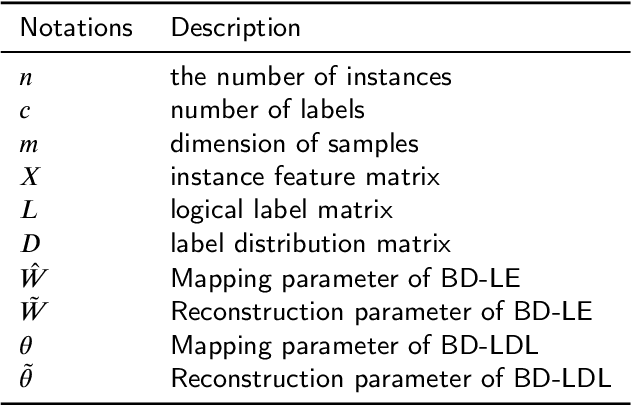
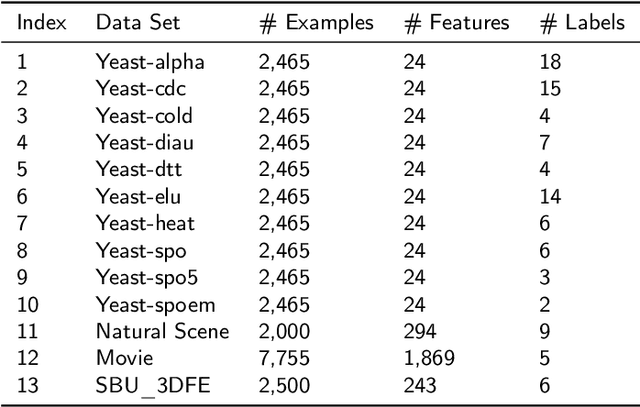

Abstract:Label distribution learning (LDL) is an interpretable and general learning paradigm that has been applied in many real-world applications. In contrast to the simple logical vector in single-label learning (SLL) and multi-label learning (MLL), LDL assigns labels with a description degree to each instance. In practice, two challenges exist in LDL, namely, how to address the dimensional gap problem during the learning process of LDL and how to exactly recover label distributions from existing logical labels, i.e., Label Enhancement (LE). For most existing LDL and LE algorithms, the fact that the dimension of the input matrix is much higher than that of the output one is alway ignored and it typically leads to the dimensional reduction owing to the unidirectional projection. The valuable information hidden in the feature space is lost during the mapping process. To this end, this study considers bidirectional projections function which can be applied in LE and LDL problems simultaneously. More specifically, this novel loss function not only considers the mapping errors generated from the projection of the input space into the output one but also accounts for the reconstruction errors generated from the projection of the output space back to the input one. This loss function aims to potentially reconstruct the input data from the output data. Therefore, it is expected to obtain more accurate results. Finally, experiments on several real-world datasets are carried out to demonstrate the superiority of the proposed method for both LE and LDL.
Generalized Label Enhancement with Sample Correlations
Apr 07, 2020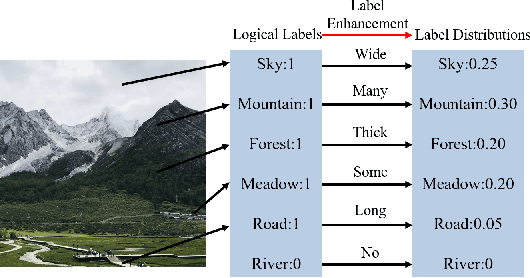
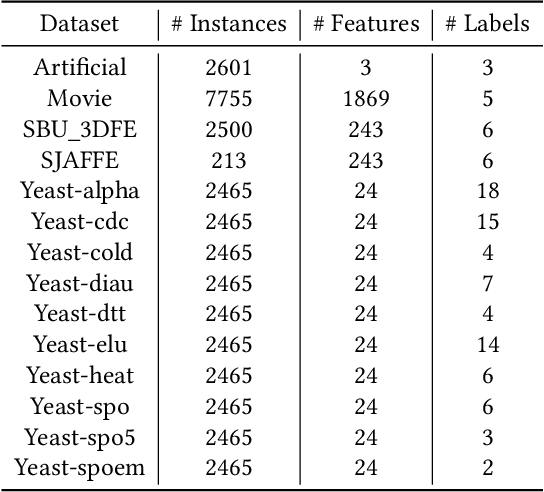
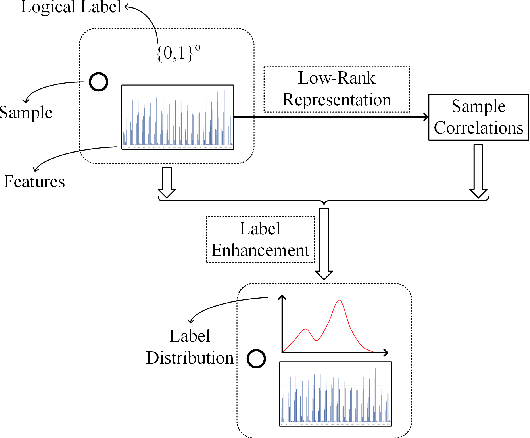
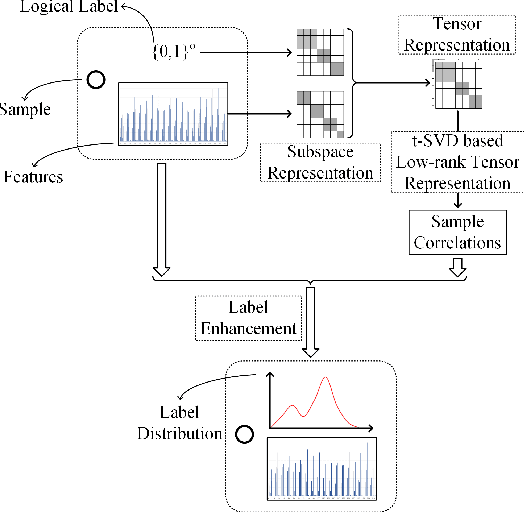
Abstract:Recently, label distribution learning (LDL) has drawn much attention in machine learning, where LDL model is learned from labeled instances. Different from single-label and multi-label annotations, label distributions describe the instance by multiple labels with different intensities and accommodates to more general conditions. As most existing machine learning datasets merely provide logical labels, label distributions are unavailable in many real-world applications. To handle this problem, we propose two novel label enhancement methods, i.e., Label Enhancement with Sample Correlations (LESC) and generalized Label Enhancement with Sample Correlations (gLESC). More specifically, LESC employs a low-rank representation of samples in the feature space, and gLESC leverages a tensor multi-rank minimization to further investigate sample correlations in both the feature space and label space. Benefit from the sample correlation, the proposed method can boost the performance of LE. Extensive experiments on 14 benchmark datasets demonstrate that LESC and gLESC can achieve state-of-the-art results as compared to previous label enhancement baselines.
 Add to Chrome
Add to Chrome Add to Firefox
Add to Firefox Add to Edge
Add to Edge